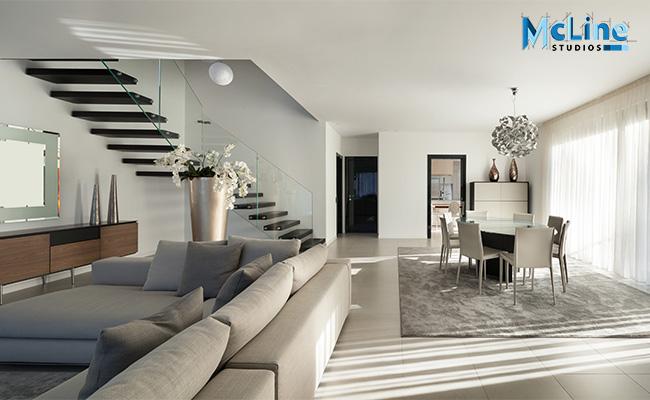Interior Shop Drawings for Kitchens, Wardrobes, and Beyond

In interior design and construction, every detail matters. From the sleek lines of a modern kitchen to the tailored functionality of a custom wardrobe, precision is what transforms a design concept into a finished masterpiece.
This is where interior shop drawings play a crucial role. Far more than just technical sketches, these drawings act as a bridge between design intent and flawless execution, ensuring that every measurement, material, and joinery detail is clear before fabrication and installation begin.
Whether it’s kitchens, wardrobes, wall paneling, or other bespoke interiors, shop drawings provide a detailed roadmap for contractors, fabricators, and installers to follow.
They eliminate guesswork, reduce costly errors, and keep projects aligned with both the client’s vision and the designer’s specifications.
In short, shop drawings are the behind-the-scenes blueprint that ensures creativity meets craftsmanship—bringing interiors to life with accuracy and efficiency.
What Are Interior Shop Drawings?
Interior shop drawings are detailed technical drawings that illustrate the construction and installation of various components within an interior project. They act as a bridge between the designer’s vision and the actual construction process. Unlike design drawings, which focus on ideas and looks, shop drawings focus on exact measurements, materials, finishes, and the way things will fit together.
For example, suppose you are making a kitchen, a wardrobe, or office furniture. In that case, shop drawings explain the exact size of cabinets, placement of shelves, thickness of panels, and even the type of hinges or handles to be used. This level of detail helps fabricators and installers understand exactly what to build, reducing mistakes and saving time during installation.
These drawings are usually prepared by contractors, fabricators, or specialized draftsmen based on the designer’s or architect’s plans. They are then reviewed and approved before work begins. Once approved, they serve as the main guide for production and installation.
The biggest benefit of shop drawings is accuracy. They ensure that all pieces fit perfectly in the space, materials are used correctly, and the final outcome matches the design intent. Without them, there is a higher chance of errors, rework, and delays.
In simple terms, interior shop drawings are like a step-by-step manual for turning design ideas into real, high-quality interiors. They bring clarity to everyone involved in the project—designers, contractors, and clients—making sure the final result is both beautiful and precise.
Importance of Shop Drawings in Interior Projects
Shop drawings play a very important role in interior projects because they turn design ideas into clear instructions for building and installation. While design drawings show the overall look and feel, shop drawings give exact details such as dimensions, materials, joints, and finishes. This makes them a practical guide for fabricators, contractors, and installers.
One of the main reasons shop drawings are important is accuracy. Interiors often include custom elements like kitchens, wardrobes, and office furniture, where every millimeter counts. Shop drawings ensure that each part is made to the right size and fits perfectly in the given space. This reduces errors and avoids costly rework.
They also help with coordination between different teams. Designers, engineers, contractors, and fabricators all use shop drawings to stay on the same page. This prevents confusion, delays, and conflicts during the project.
Another benefit is quality control. Since the drawings clearly mention materials, finishes, and installation methods, the final output closely matches the original design intent. Clients can also review these drawings before work begins, which builds confidence and avoids misunderstandings later.
In addition, shop drawings save time and money. By spotting potential problems in advance, they prevent mistakes during production or on-site work. This makes the project smoother and more efficient.
Shop Drawings for Kitchens
Shop drawings for kitchens are detailed technical drawings that explain how every part of the kitchen will be made and installed. They go beyond the design stage and show exact measurements, materials, finishes, and the way different elements fit together. These drawings act as a guide for fabricators, carpenters, and installers to ensure the kitchen is built exactly as planned.
For example, a kitchen shop drawing will include the size and position of cabinets, shelves, countertops, and appliances. It will also show details like the thickness of panels, the type of hinges or handles, and even where electrical and plumbing points should be placed. With this level of detail, everyone involved knows what to do, reducing mistakes during production and installation.
One big advantage of kitchen shop drawings is accuracy. Kitchens often have custom layouts, and even a small measurement error can cause problems when fitting cabinets or appliances. Shop drawings make sure everything is precise and fits well in the given space.
They also improve coordination between designers, contractors, and clients. Clients can review the drawings before work begins, which avoids confusion and ensures the final result matches their expectations.
Shop Drawings for Wardrobes
Shop drawings for wardrobes are detailed plans that show exactly how a wardrobe will be made and installed. They are different from design drawings because they focus on technical details like dimensions, materials, finishes, and fittings. These drawings help fabricators and carpenters understand every part of the wardrobe, making sure it is built correctly and fits perfectly in the space.
For example, a wardrobe shop drawing will show the height, width, and depth of the unit, the number of shelves, drawers, and hanging spaces, as well as the thickness of the panels. It can also include details about the type of handles, hinges, sliding systems, or lighting to be used. By providing this information, shop drawings act as a clear instruction manual for production and installation.
The biggest benefit of wardrobe shop drawings is accuracy. Since wardrobes are often custom-made to fit into specific spaces, even a small mistake in measurement can cause problems. Shop drawings prevent these errors by giving precise information before work starts.
They also improve communication between designers, contractors, and clients. Clients can see how the wardrobe will look and function, and suggest changes if needed before production begins. This saves both time and money by avoiding rework later.
Shop Drawings Beyond Kitchens and Wardrobes
Shop drawings are not limited to kitchens and wardrobes—they are useful for many other interior elements as well. In fact, any custom-made furniture or fixture in a project can benefit from shop drawings. These drawings provide the exact details needed for fabrication and installation, ensuring that the final product looks good, works well, and fits perfectly in the space.
For example, shop drawings can be made for TV units, office workstations, reception desks, bathroom vanities, wall paneling, ceilings, and even decorative partitions. Each of these elements has unique measurements, materials, and finishes that need to be clearly defined. Without detailed drawings, there is a higher chance of mistakes, delays, and extra costs.
The main advantage of using shop drawings for these items is precision. Whether it’s a custom bookshelf or a hotel lobby counter, the drawing shows exact dimensions and construction details. This makes it easier for carpenters, fabricators, and installers to follow the plan without confusion.
Another benefit is coordination. Interior projects often involve multiple trades such as carpentry, electrical, plumbing, and lighting. Shop drawings help align these works so everything fits together smoothly. For example, a drawing for a TV wall unit may also indicate wiring points and light fittings.
In simple terms, shop drawings go far beyond kitchens and wardrobes. They bring clarity, save time, and ensure quality for all types of interior elements, making them a key tool in delivering successful projects.
Our Thoughts
Interior shop drawings are the backbone of successful interior projects. Whether it’s a modern kitchen, a custom wardrobe, or other bespoke elements like TV units, wall paneling, or reception desks, these detailed drawings ensure that every idea is transformed into reality with precision. They bridge the gap between design and execution by providing clear instructions on measurements, materials, and finishes, leaving no room for guesswork.
By improving accuracy, coordination, and communication, shop drawings save time, reduce costs, and prevent errors that can delay a project. They also give clients the chance to review and approve details before work begins, ensuring the final result matches their expectations.
In short, shop drawings are not just technical documents—they are the foundation that combines creativity with craftsmanship. They bring clarity to the process, guide every stakeholder, and guarantee that the final interior is both functional and beautiful. For any interior project, shop drawings are not optional but essential for achieving flawless results.







